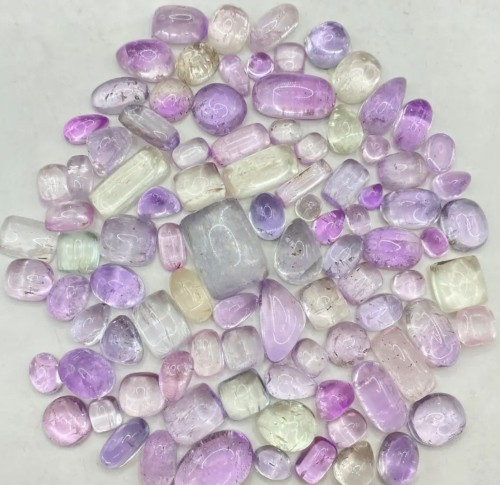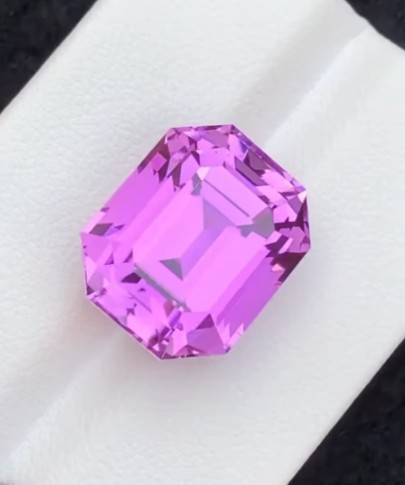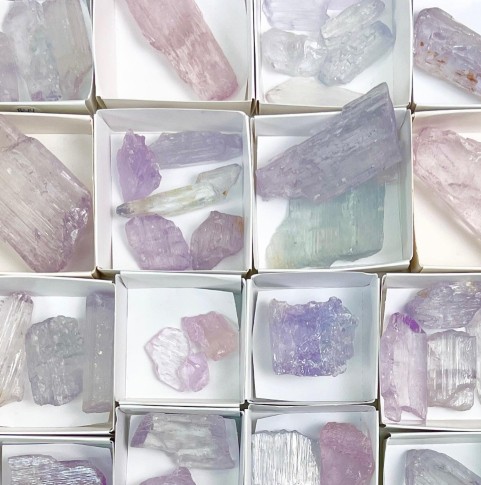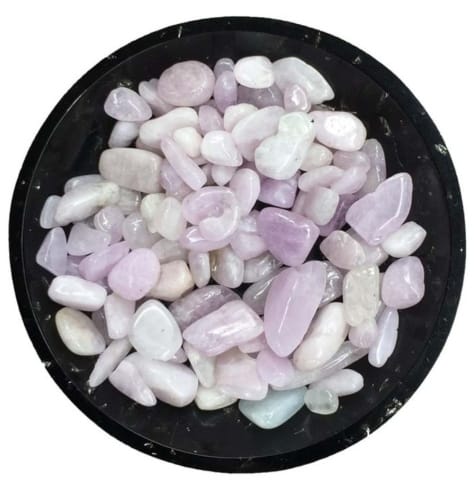Kunzite is a mineral variety of spodumene and is named after the gemologist George Fredrick Kunz who was the first to identify it. Kunzite’s delicate color comes from trace amounts of manganese and the crystal displays a deeper color down the “C” axis while a pale color is visible on the “A” axis.
Kunzite is the best-known variety of spodumene while the green variety, hiddenite, is a close second and the yellow variety, triphane, rounds out third. Despite kunzite’s rarity, it’s often affordable as it’s relatively unknown amongst the general public.
How to Identify Kunzite Through Testing
There are various ways to identify rocks, minerals, crystals, and gemstones, but we will use a method I learned while attending the Gemological Institute of America. If you’ve learned a unique way to identify gems, please share it with us.
Let’s look deeper into how to identify kunzite like a pro.

Visual Inspection
The visual inspection starts with what form of kunzite you have. The questions below are relatively easy to answer, but each type will have its own process for identifying them.

Is it a cabochon? A cabochon should have a high polish with little to no pitting. When viewing the cabochon you will notice the pastel colors and some natural inclusions. If you’re dealing with lower quality then you’ll see white streaks mixed in with the pastel colors. Most cabs will be in the standard shapes but you could see free-form cabs from lapidary artists.

Is it faceted? If you have a faceted piece of kunzite it should be purple or pink in color. The shade of the color will vary between stones but deeper-cut stones produce a richer color to the eye. You’ll need a 10X powered loop to determine clarity and to look for natural inclusions to assist you with identification.
If you need help valuing and pricing kunzite then use my free guide.

Is it a specimen? Kunzite is found in different forms and you’ll get better at identifying these forms by looking at and inspecting this mineral over time. This stone is monoclinic, and its crystals typically take on a blade-like shape. Kunzite can be found in pegmatite deposits, usually along with beryl, tourmaline, and other beautiful gems. Here’s a list of characteristics kunzite displays when it’s a specimen.
- Blade-like in shape.
- Colors range from colorless to light pink and light violet.
- Inclusions are common.
- Sizes vary from small to medium.

Is it tumbled? Very common to find tumbled kunzite because lower-grade material is readily available and the tumbled pieces offer a great price point for crystal collectors. Again, there will be a medium to high polish. Colors range from white to whitish-pink and whitish-purple.
Physical Properties of Kunzite
Let’s take a look at the physical properties of Kunzite. Knowing what to look for will help you more easily identify what you’re looking at.
Color: Pink, Violet, Violet-Pink, White, Colorless, Gray, Green, Yellow, Brown, Sometimes it’s Colorless
Clarity / Transparency: Transparent to Opaque
Luster: Vitreous
Cleavage: Perfect
Fracture: Uneven
The Streak Test
This is a destructive test, so you need to ensure that you’re allowed to damage the specimen or stone if you choose to use this method. Once you’ve developed robust knowledge in identifying rocks and minerals, you won’t use destructive tests.
A mineral streak test is when you scrape the stone against a harder surface to see what color remains. Kunzite produces a white streak.
Tumbled specimens are tested by scraping samples across a piece of ungalvanized porcelain, typically known as a streak plate.
Magnet Test
Kunzite is diamagnetic, so the magnet test will not confirm or deny its identity. Because Kunzite is diamagnetic, it is repelled by magnets.
Hardness Test
I don’t recommend actively testing the hardness of a stone because it’s destructive in nature and doesn’t really provide a definite answer to what type of stone it is. That said, kunzite has a hardness of 6 to 7 on the Mohs hardness scale.
Refractive Index Test
Determining the refractive index, or RI as it’s referred to by gemologists, for kunzite is relatively straightforward, but you’ll need a specific piece of test equipment and the RI fluid to go with it. Before you place the stone on the refractometer, you want to make sure you have a flat, somewhat polished surface to take a reading.
Kunzite’s Refractive Index: 1.657 – 1.681
Each gemstone has its own RI, so discovering a sample’s RI can help you figure out what sort of stone it actually is.
Step 1 – Place a small bead of RI fluid on the metal surface of the refractometer near the back of the crystal hemicylinder (the window on which the stone will sit).
Step 2 – Place the stone facet face down on the fluid dot and slide it toward the middle of the hemicylinder crystal using your fingers.
Step 3 – Look through the viewer lens without magnification. Continue looking until you see the outline of a bubble, then look at the bottom of this bubble. Take the reading from there, rounding the decimal to the nearest hundredth.
Occasionally, you’ll run into the issue of not having a flat surface to work with. In this instance, you’ll need to leave the top of the refractometer open and hold the rounded stone with your hand. Hopefully, you’ll be able to pull a reading off of the gauge.
Birefringence Test
Consider testing the birefringence, as well. Birefringence is related to RI. While doing the birefringence test, you will turn the gemstone on the refractometer six times throughout the observation period and note the changes.
Perform a standard RI test. Instead of keeping the stone still, gradually turn it 180 degrees, making each separate turn about 30 degrees. At each 30-degree mark, take a new RI reading.
Subtract the lowest reading from the highest to find the stone’s birefringence. Round it to the nearest thousandth.
Birefringence: 0.014 – 0.016
Single or Double Refraction
Kunzite is slightly doubly refractive.
The stone must be transparent for this test to be accurate and beneficial. If the light won’t pass through the stone, there is no way to test for single or double refraction.
Check for single or double refraction. Use this test on translucent and transparent stones. You can determine whether the stone is only singly refractive (SR) or doubly refractive (DR) to help identify it. Some stones can also be classified as aggregate (AGG).
Turn on the light of a polariscope and place the stone face down on the lower glass lens (polarizer). Look through the top lens (analyzer), turning the top lens until the area around the stone looks darkest. This is your starting point.
Turn the analyzer 360 degrees and watch how the light around the stone changes.
If the stone appears dark and stays dark, it is likely an SR. If the stone starts out light and remains light, it is likely AGG. If the lightness or darkness of the stone changes, it is likely DR.
Checking The Diaphaneity
Diaphaneity refers to the mineral’s ability to transmit light. For instance, some minerals are transparent or translucent. A small amount of distortion might occur when they’re thick, but light will pass through them relatively freely.
Kunzite is transparent to translucent.
Finding The Specific Gravity
Every stone has its unique specific gravity, which helps us identify them. Specific gravity is one of the best properties to measure when identifying mineral specimens. Most minerals have a narrow range of specific gravity, so getting an accurate measurement can go a long way toward identification.
Specific gravity is a unitless number describing how heavy a mineral is compared to equal volumes of water. For example, if a mineral is three times as dense as water, it’ll have a specific gravity of three. This is useful because while two minerals might be the same size, they’ll each have a different specific gravity.
The larger the sample, the more precise the readings tend to be. Remember that this technique can only be used for single mineral or crystal masses. It will not work for minerals embedded in host rocks.
Kunzite’s Specific Gravity: 3.15 – 3.21
As helpful as specific gravity is for identifying minerals, amateurs are usually constrained by the need for more necessary tools for the job. However, one way to work around this is to hold the specimen and note how heavy or heft it feels compared to what you might expect a specimen of that size to weigh.
If you want to determine the specific gravity of your stone like a pro, you’ll need to invest in a higher-end scale. The OHAUS Density Determination Kit is the one gemologists use.
Identifying Rocks and Minerals Like a Pro
Hopefully, you feel confident in your practice of identifying a piece of kunzite after reading and applying this guide. You’ll be using the visual part of this guide the most, and you’ll get better as you interact with more gemstones. Before you know it, you’ll be identifying stones like a gemologist.
Feel free to reach out if you encounter any issues or need clarification. I’ll do my best to assist you in the identification process.
- Identify Enstatite - March 12, 2024
- Identify Cerussite - March 3, 2024
- Identify Bytownite - February 18, 2024
